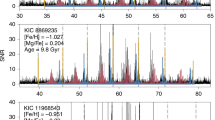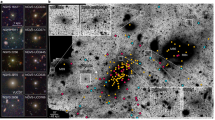Abstract
More than half of all stars in the local Universe are found in massive spheroidal galaxies1, which are characterized by old stellar populations2,3 with little or no current star formation. In present models, such galaxies appear rather late in the history of the Universe as the culmination of a hierarchical merging process, in which larger galaxies are assembled through mergers of smaller precursor galaxies. But observations have not yet established how, or even when, the massive spheroidals formed2,3, nor if their seemingly sudden appearance when the Universe was about half its present age (at redshift z ≈ 1) results from a real evolutionary effect (such as a peak of mergers) or from the observational difficulty of identifying them at earlier epochs. Here we report the spectroscopic and morphological identification of four old, fully assembled, massive (1011 solar masses) spheroidal galaxies at l.6 < z < 1.9, the most distant such objects currently known. The existence of such systems when the Universe was only about one-quarter of its present age shows that the build-up of massive early-type galaxies was much faster in the early Universe than has been expected from theoretical simulations4.
This is a preview of subscription content, access via your institution
Access options
Subscribe to this journal
Receive 51 print issues and online access
$199.00 per year
only $3.90 per issue
Buy this article
- Purchase on Springer Link
- Instant access to full article PDF
Prices may be subject to local taxes which are calculated during checkout




Similar content being viewed by others
References
Fukugita, M., Hogan, C. J. & Peebles, P. J. E. The cosmic baryon budget. Astrophys. J. 503, 518–530 (1998)
Renzini, A. in The Formation of Galactic Bulges (eds Carollo, C. M., Ferguson, H. C. & Wyse, R. F. G.) 9–26 (Cambridge Univ. Press, Cambridge, UK, 1999)
Peebles, P. J. E. in A New Era in Cosmology (eds Metcalfe, N. & Shanks, T.) 351–361 (ASP Conf. Proc. Vol. 283, Astronomical Society of the Pacific, San Francisco, 2002)
Somerville, R. S. et al. The redshift distribution of near-infrared-selected galaxies in the Great Observatories Origins Deep Survey as a test of galaxy formation scenarios. Astrophys. J. 600, L135–L139 (2004)
Freedman, W. L. & Turner, M. S. Colloquium: Measuring and understanding the universe. Rev. Mod. Phys. 75, 1433–1447 (2003)
Im, M. et al. The DEEP Groth strip survey. X. Number density and luminosity function of field E/SO galaxies at z < 1. Astrophys. J. 571, 136–171 (2002)
Cimatti, A. et al. The K20 survey. I. Disentangling old and dusty star-forming galaxies in the ERO population. Astron. Astrophys. 381, L68–L73 (2002)
Benitez, N. et al. Detection of evolved high-redshift galaxies in deep NICMOS/VLT images. Astrophys. J. 515, L65–L69 (1999)
Daddi, E. et al. Detection of strong clustering of extremely red objects: implications for the density of z > 1 ellipticals. Astron. Astrophys. 361, 535–549 (2000)
Zepf, S. E. Formation of elliptical galaxies at moderate redshifts. Nature 390, 377–380 (1997)
Rodighiero, G., Franceschini, A. & Fasano, G. Deep Hubble Space Telescope imaging surveys and the formation of spheroidal galaxies. Mon. Not. R. Astron. Soc. 324, 491–497 (2001)
Taniguchi, Y. et al. Lymanα emitters beyond redshift 5: The dawn of galaxy formation. J. Korean Astron. Soc. 36, 123–144 (2003)
Dunlop, J. S. et al. 3.5-Gyr-old galaxy at redshift 1.55. Nature 381, 581–584 (1996)
Spinrad, H. et al. LBDS 53W091: an old, red galaxy at z = 1.552. Astrophys. J. 484, 581–601 (1997)
Gavazzi, G., Pierini, D. & Boselli, A. The phenomenology of disk galaxies. Astron. Astrophys. 312, 397–408 (1996)
Cimatti, A. et al. The K20 survey. III. Photometric and spectroscopic properties of the sample. Astron. Astrophys. 392, 395–406 (2002)
Giavalisco, M. et al. The Great Observatories Origins Deep Survey: Initial results from optical and near-infrared imaging. Astrophys. J. 600, L93–L98 (2004)
Pickles, A. J. A stellar spectral flux library: 1150–25000 Å. Publ. Astron. Soc. Pacif. 110, 863–878 (1998)
Bruzual, G. & Charlot, S. Stellar population synthesis at the resolution of 2003. Mon. Not. R. Astron. Soc. 344, 1000–1028 (2003)
Jimenez, R. et al. Synthetic stellar populations: single stellar populations, stellar interior models and primordial proto-galaxies. Mon. Not. R. Astron. Soc. 349, 240–254 (2004)
Eisenstein, D. J. et al. Average spectra of massive galaxies in the Sloan Digital Sky Survey. Astrophys. J. 585, 694–713 (2003)
Cole, S. et al. The 2dF galaxy redshift survey: near-infrared galaxy luminosity functions. Mon. Not. R. Astron. Soc. 326, 255–273 (2001)
Daddi, E. et al. Near-infrared bright galaxies at z ∼ 2. Entering the spheroid formation epoch? Astrophys. J. 600, L127–L131 (2004)
Davis, M. & Geller, M. J. Galaxy correlations as a function of morphological type. Astrophys. J. 208, 13–19 (1976)
Dickinson, M., Papovich, C., Ferguson, H. C. & Budavari, T. The evolution of the global stellar mass density at 0 < z < 3. Astrophys. J. 587, 25–40 (2003)
Steidel, C. C. et al. A survey of star-forming galaxies in the z = 1.4-2.5 ‘redshift desert’: Overview. Astrophys. J. 604, 534–550 (2004)
Genzel, R. et al. Spatially resolved millimeter interferometry of SMM J02399-0136: A very massive galaxy at z = 2.8. Astrophys. J. 584, 633–642 (2003)
Franx, M. et al. A significant population of red, near-infrared-selected high-redshift galaxies. Astrophys. J. 587, L79–L83 (2003)
Pignatelli, E. & Fasano, G. GASPHOT: A tool for automated surface photometry of galaxies. Astrophys. Space Sci. 269, 657–658 (1999)
Peng, C. Y., Ho, L. C., Impey, C. D. & Rix, H.-W. Detailed structural decomposition of galaxy images. Astron. J. 124, 266–293 (2002)
Acknowledgements
This work is based on observations made at the European Southern Observatory, Paranal, Chile, and with the NASA/ESA Hubble Space Telescope obtained at the Space Telescope Science Institute, which is operated by the Association of Universities for Research in Astronomy (AURA). We thank R. Somerville for information on the GOODS/CDFS mock catalogue. We are grateful to the GOODS Team for obtaining and releasing the HST and FORS2 data
Author information
Authors and Affiliations
Corresponding author
Ethics declarations
Competing interests
The authors declare that they have no competing financial interests.
Supplementary information
Supplementary table 1
The detected galaxies. (PDF 24 kb)
Rights and permissions
About this article
Cite this article
Cimatti, A., Daddi, E., Renzini, A. et al. Old galaxies in the young Universe. Nature 430, 184–187 (2004). https://doi.org/10.1038/nature02668
Received:
Accepted:
Issue Date:
DOI: https://doi.org/10.1038/nature02668
This article is cited by
-
A massive quiescent galaxy at redshift 4.658
Nature (2023)
-
Unveiling the Universe with emerging cosmological probes
Living Reviews in Relativity (2022)
-
Chronos: A NIR spectroscopic galaxy survey to probe the most fundamental stages of galaxy evolution
Experimental Astronomy (2021)
-
Linear expansion models vs. standard cosmologies: a critical and historical overview
Astrophysics and Space Science (2020)
-
A massive, quiescent galaxy at a redshift of 3.717
Nature (2017)
Comments
By submitting a comment you agree to abide by our Terms and Community Guidelines. If you find something abusive or that does not comply with our terms or guidelines please flag it as inappropriate.



